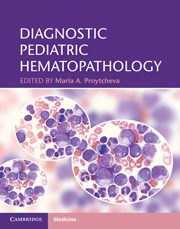Book contents
- Frontmatter
- Contents
- List of contributors
- Acknowledgements
- Introduction
- Section 1 General and non-neoplastic hematopathology
- 1 Hematologic values in the healthy fetus, neonate, and child
- 2 Normal bone marrow
- 3 Disorders of erythrocyte production
- 4 Disorders of hemoglobin synthesis
- 5 Hemolytic anemias
- 6 Inherited and acquired bone marrow failure syndromes associated with multiple cytopenias
- 7 Inherited bone marrow failure syndromes and acquired disorders associated with single peripheral blood cytopenia
- 8 Peripheral blood and bone marrow manifestations of metabolic storage diseases
- 9 Reactive lymphadenopathies
- Section 2 Neoplastic hematopathology
- Index
- References
9 - Reactive lymphadenopathies
from Section 1 - General and non-neoplastic hematopathology
Published online by Cambridge University Press: 03 May 2011
- Frontmatter
- Contents
- List of contributors
- Acknowledgements
- Introduction
- Section 1 General and non-neoplastic hematopathology
- 1 Hematologic values in the healthy fetus, neonate, and child
- 2 Normal bone marrow
- 3 Disorders of erythrocyte production
- 4 Disorders of hemoglobin synthesis
- 5 Hemolytic anemias
- 6 Inherited and acquired bone marrow failure syndromes associated with multiple cytopenias
- 7 Inherited bone marrow failure syndromes and acquired disorders associated with single peripheral blood cytopenia
- 8 Peripheral blood and bone marrow manifestations of metabolic storage diseases
- 9 Reactive lymphadenopathies
- Section 2 Neoplastic hematopathology
- Index
- References
Summary
Introduction
Lymphadenopathies occur frequently during childhood, and their incidence varies with age. In a majority of children, lymph node enlargement is transient, self-limited, and resolves without sequel, and lymph node biopsies are rarely performed. When a lymph node biopsy is performed, the primary goal of histologic examination is to determine the nature of the process: whether it is a malignant or benign, lymphoid or non-lymphoid proliferation.
This chapter focuses on reactive lymphoid proliferations in children. The chapter will first summarize key points in the development and functional anatomy of lymph nodes, then will discuss the epidemiology of pediatric lymphadenopathies and finally will describe the most frequent types of reactive lymphoid proliferations in children. Since characterization of all lymphadenopathies is beyond the scope of a single chapter, here we will focus on those entities that present major diagnostic challenges in distinguishing benign from malignant disorders, as well as those pediatric lymphadenopathies that are seen in conjunction with specific syndromes.
Embryonal development of lymph nodes
Lymph nodes, similarly to the other secondary lymphoid organs, have a specialized architecture and microenvironment promoting controlled interactions of immune cells in order to elicit a rapid and appropriate immune response to infectious agents. Knowledge of the development and functional anatomy of lymph nodes is important since many of the morphologic changes observed in reactive conditions reflect lymph node function and its role in the normal immune response.
- Type
- Chapter
- Information
- Diagnostic Pediatric Hematopathology , pp. 142 - 182Publisher: Cambridge University PressPrint publication year: 2011



